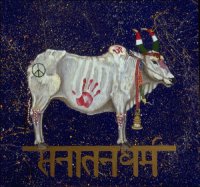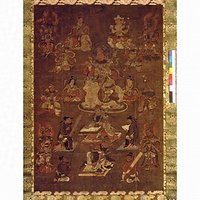:::::::::::::::::::::::::::::::::::::::::::::::::::::::::::::::::::::::::::::::::::::::::::::::::::::
Daruma and the Cow / Oxen / Water Buffalo
牛 水牛
2009, the Year of the Ox

This is a Daruma I got from Hoorin-Ji Temple in Kyoto 法輪寺, a Daruma temple that provides clay bells of the Asian zodiac animals with a Daruma for each year. More see below.
Gabi Greve
:::::::::::::::::::::::::::::::::::::::::::::::::::::::::::::::::::::::::::::::::::::::::::::::::::::
東京国際フォーラム前


source
http://futtemoharetemo.blog32.fc2.com/blog-entry-400.html
:::::::::::::::::::::::::::::::::::::::::::::::::::::::::::::::::::::::::::::::::::::::::::::::::::::
The Holy Cow in India

Paint the Holy Cow.com
ooooooooooooooooooooooooo
QUOTE:
India's majority Hindu community reveres cowsand considers them to be "second mothers" .
About 8,000 years ago, the relationship between cows and man began with the revolutionary advent of domestication in Mesopotamia, the Indus River Valley, and Africa. There were many possible candidates for the job but only the cow fit the specific criteria humankind needed: not too flighty, breeds well in captivity, grows at a good pace, not aggressive, requires a low maintenance diet.
Our ancestors chose wisely: Cows provide just about all of our basic needs, from milk and meat to muscle.
http://www.pbs.org/wnet/nature/holycow/
There will be more.
:::::::::::::::::::::::::::::::::::::::::::::::::::::::::::::::::::::::::::::::::::::::::::::::::::::

source : blog.goo.ne.jp/seigetu23
Darumoooo !
for friends at the
Moooo! Bar Shiraishi Island, Japan
- source : www.moooobar.com
:::::::::::::::::::::::::::::::::::::::::::::::::::::::::::::::::::::::::::::::::::::::::::::::::::::
The famous Ox-Herding Zen Paintings
Searching for the Ox

Picture Nr. 6
Coming home on the cow's back
The struggle is over; he is no more concerned with gain and loss.
He hums a rustic tune of the woodman, he sings simple songs of the village boy. Saddling himself on the cow's back, his eyes are fixed on things not of the earth, earthy. Even if he is called to, he will not turn his head; however enticed, he will no more be kept back.
Riding the cow he leisurely wends his way home,
Enveloped in the evening mist, how tunefully the flute vanishes away!
Singing a ditty, beating time, his heart is filled with a joy indescribable!
That he is now one of those who know, need it be told?
If anyone should ask the meaning of this,
Behold the lilies of the field and its fresh sweet-scented verdure.
source : D.T. Suzuki
Many Links to the Oxherding paintings
Oxherding pictures by TOMIKICHIRO TOKURIKI
十牛圖 Shiniu tu [Jūgyūzu] "10 Bulls"
by 廓庵師遠 Kuoan Shiyuan [Kakuan Shien]
and
by 德力富吉郎 Tokuriki Tomikichirō
source : terebess.hu
extensive reference
:::::::::::::::::::::::::::::::::::::::::::::::::::::::::::::::::::::::::::::::::::::::::::::::::::::
Buddha Statues and Cows (Bulls, Oxen)
One of the five great wisdom kings, Daiitoku 大威徳明王, is riding a white cow, symbol of enlightenment.
大威徳明王騎牛像

The Cow is also in the seiza, seated position. Sometimes he is depicted with six legs. Sometimes he has six faces with three eyes each, making it 18 eyes.
Read Mark Schumacher about Daiitoku
ooooooooooooooooooooooooooooooooooo
大威徳明王 Daiitoku Myo-O

Sometimes depicted with six arms and three faces, and riding on six cows.
五大明王の一。西方に配しを阿彌陀とする。三面六臂大白牛に乗る。梵名曼徳迦、降焔魔尊、六足尊など別称する。悪を伏する勢いあるを大威といい、善を護る功あるを大徳と云う。明王の中の大威徳、菩薩の中の大威徳、迦ル羅王の中の大威徳、各其の性徳を以て名付く。
別称六足尊は、この尊が六足を有すればなり。但し六頭六面六臂六足、所乗の牛も六牛なれども獨り六足と名づくるは多足は此の尊に限ればなり。西方無量壽佛の忿怒尊にして文殊菩薩の所現なり。
http://homepage3.nifty.com/MandalaExplorer/taizou_kai/tai_2/tai_010-014/tai_011.html
:::::::::::::::::::::::::::::::::::::::::::::::::::::::::::::::::::::::::::::::::::::::::::::::::::::
Daijizai Ten 大自在天
(Makei Shura Ten 摩醯首羅天 (まけいしゅら), Shookara, Maheshvara)
Buddhist version of the destructor Shiva or the wild Rudra.
He is seated on a black-blue water buffalo. Other sources quote a white buffalo.
Ishana Ten, protector of the North-East
also seated on a yellow buffalo. He later became Daijizai Ten.
伊舎那天 東北 諸の魔衆の主
風力を神格化したもので、のちに大自在天、すなわちシヴァ神の化身といわれ、シヴァ神と同一視されるようになり、大自在天によくた姿をしています。忿怒相で三眼をもち、牙を上に突き出している。右手に三叉戟、左手に杯をもち牛に乗ります。 黄色の牛に乗る。浅青肉色.
http://www.sakai.zaq.ne.jp/piicats/jyuuniten.htm
Read Mark Schumacher about Daijizaiten (with illustration).
:::::::::::::::::::::::::::::::::::::::::::::::::::::::::::::::::::::::::::::::::::::::::::::::::::::
Cow-Headed Deities
Kannon With Horse's Head (Batou Kannon Batoo Kannon, 馬頭観音)
QUOTE:
Says site reader and contributor GABI
"By neighing like a horse, these deities ward off the bad demons. Batoo Kannon has been known in Japan since 7th century. She is especially honored by the horse breeders in Northern Japan. Nowadays you even find bicycles in front of the stone votive statues on waysides.
There is also a version with the head of an ox (gotoo Kannon, gozu Kannon, gyuutoo Kannon 牛頭観音) or a pig (tontoo Kannon 豚頭観音). ”
Read Mark Schumacher on the Horse-headed Kannon
xxxxxxxxxxxxxxxxxxxxxxxxxxxxxxxxx
More about the Ox-headed Kannon
Sometimes it is only a stone marker with the Chinese characters 牛頭観音 or 牛頭観世音inscribed in it.
大佐の牛頭観音群 広島県庄原市西城町大佐
A group of Stone Statues with Ox-headed Kannon in Osa.

馬頭観音だとばかり思っていたが、よくよく見ると観音様の頭には角が生えており牛頭観音だった。 もっとも牛頭観音という観音様はいないので牛頭を抱いた馬頭観音さまということになるのだろうか。
http://www.asahi-net.or.jp/~rn2h-dimr/ohaka2/20tikusan/26cyugoku/h_osa.html
xxxxxxxxxxxxxxxxxxxxxxxxxxxxxxx
Stone Marker of Ox-headed Kannon in Kawachi
さて、牛と私たちの関係は古く、弥生時代の登呂遺跡(静岡県静岡市)から骨が発掘され、奈良時代には運搬や農耕、乳牛として飼育されたことが文献に見られます。 牛乳は当時から薬として用いられ「蘇(そ)」、「生蘇(なまそ)」と呼ばれ、現在のチーズやヨーグルトの様なものとして貴族階級などで食されていました。
http://www.town.kawachi.tochigi.jp/08tanbou/270/263.html
xxxxxxxxxxxxxxxxxxxxxxxxxxxxxxx
More Links:
これは、本来の解釈とは異なり、無病息災(むびょうそくさい)の祈願や死んだ後の供養が目的と考えられます。 家畜に対する信仰は、馬に限らず、牛や豚にも行われるようになりました。市内にも、牛頭(ぎゅうとう)観音が存在しています。
http://www.city-sakado.com/shiryou/bunkazai/dayori2002_01/dayori_2001_12.htm
牛頭観音も馬頭観音と同様の感謝を表しているのであろう。
箱根の笹原新田で「牛馬頭観音」、興津の興津川畔で「牛頭観音」を見た。
大変珍しいものと思っていたが、実は全国的に広がっているものらしい。
http://oguri.cside1.jp/tokaimemo01.htm
:::::::::::::::::::::::::::::::::::::::::::::::::::::::::::::::::::::::::::::::::::::::::::::::::::::
The Ox-headed Myo-O, Gozu Myoo-Oo 牛頭明王
A Statue of such a Myo-O at Hanno Town, Bamboo Temple 竹寺
There is even a special hall for this deity.

日中友好の証として牛頭明王が中国民間人有志の協力で平成4年に寄贈されました。
http://www10.ocn.ne.jp/~kosuke/hannou/hannou3.html
. Somin Shoorai Fu 蘇民将来符 Somin Shorai amulet .
and Gozu Tenno 牛頭天王
:::::::::::::::::::::::::::::::::::::::::::::::::::::::::::::::::::::::::::::::::::::::::::::::::::::
Heavenly King with an Ox-Head,
Bull Head Heavenly King, Ox-Headed Deva King
gozu tennoo, gozu tenoo 牛頭天王
The Japanese god of plague / Der japanische Gott der Pest
Quote by Richard Thornhill
In mediaeval times, with the fusion of Shinto and Buddhism, Susa-no-O was identified with Gozu Tenno ("Bull-headed King of Heaven"), a Baal-like Hindu god of pestilence. Such identifications were formally abolished in 1868, but he is still often popularly referred to by this name, and is usually shown with bull's horns. He is also referred to simply as Tenno ("King of Heaven"), or as Gion Tenjin ("Heavenly God of Gion").
Before 1868 all Yagumo, Yasaka, Tsushima and Susa-no-O jinja, and most Suga jinja, were called Tennosha, Gozu Tennosha, Gion Gozu Tennosha, Gion Tenjin or Gion Daimyojin.
Folklore contains numerous stories about Gozu Tenno, and it was believed that, like the Greek gods, he sometimes appears in human form requesting hospitality.
http://www.geocities.com/westhollywood/heights/4617/shinto2.html

http://homepage.hispeed.ch/rumina/gozu-tenno.htm
QUOTE:
In the middle of the Heian Period the theory known as Honji Suijaku, which refers to the manifestation of Buddha in the temporary form of a Shinto deity that tries to save people, spread throughout Japan. From this period social unrest and convulsions of nature occurred, epidemics became prevalent and people were filled with fear and anxiety. Reflecting this social unrest, the Gion Shinko originated in order to pacify vengeful spirits and quell epidemics.
This faith combined worship of the most fearful and strongest Buddhist and Shinto deities, Gozu Tenno and Susano’o. Gozu Tenno, had a head like a bull and guarded a monastery called Gion Shoja where Buddha lived. Susano’o no Mikoto successfully slew an eight-headed dragon Yamata no Orochi after being banished from the Plain of High Heaven. People believed that Susano’o no Mikoto and Gozu Tenno would overcome vengeful spirits, epidemics and devils no matter how fearsome they might be. This was indeed the new faith people had been seeking.
It is widely believed among scholars that the birthplace of Gion Shinko is Susano’o Shrine situated in Shin-ichi, Hiroshima Prefecture. We have clear evidence of this as follows:
“Kibi no Makibi was a man of unequaled intelligence in those days. In the fifth year of Tempyo he returned to Japan and met Gozu Tenno (Susano’o no Mikoto) in Banshu. It is written in an ancient document called Banyoshi that Kibi no Makibi transferred the spirit of Susano’o no Mikoto from Bingo to Hiromine, Harima (present-day Hyogo Prefecture).”
http://www.fuchu.or.jp/~eguma/e%20sinkou.htm
oooooooooooooooooooooooooo
KIRYU GION FESTIVAL
In earlier days, the Gion Festival was called "Gion-e" or "Tenno Sairei" and was held in honor of the god, Gozu Tenno. the festival was first held in Kyoto in the year 876, celebrating the beliefs of both Buddhism and Shintoism. The tutelary god of Gion Monastery was worshipped at Gion Shrine for his protective powers. This custom spread throughout the country.
From the year 1591, the town of Kiryu was formed with the earliest record of a festival being held in 1656. This was the first "Kiryu Gion". At that time, a form of children's dancing using the hands was the focus of this simple event. Near the Honcho 3 chome housing apartments there was once a temple called Shusei-In. This temple worshipped the god Gozu Tenno.
http://www.kiea.jp/Hokoza.html
oooooooooooooooooooooooooo
Beginning of the Gion Matsuri
In the case of Yasaka Shrine in Kyoto, in the 18th year of Jogan the Buddhist priest Juzen Ennyo received a divine message from Gozu Tenno (Susano’o no Mikoto) and transferred the spirit of Gozu Tenno from Hiromine in Harima to Kyoto and enshrined the spirit there.
Later Mototsune Fujiwara erected a shrine in Kyoto.
http://www.fuchu.or.jp/~eguma/e%20gionmaturi.htm
oooooooooooooooooooooooooo

This deity became popular during the Heian period, he is venerated in the pursuit to ward off diseases and physical ailments.
牛頭天王信仰が、どのような人たちによって、どのような過程を経て、民衆の中に広まっていったかについては明らかでないが、医療技術が極めて乏しかった当時、疫病を防ぐ強い霊力を持つとされた牛頭天王に対する信仰が、平安時代末期から中世にかけて、燎源の火のように広まったことは想像に難くない。
そして、牛頭天王は略して単に「天王」と呼ばれた。民衆にとって、「てんのう」とは、天皇のことではなく牛頭天王のことであった。
Very detailed LINK:
http://www.infonet.co.jp/nobk/minoh/gozutenno.htm
. Gion Festival and related KIGO
:::::::::::::::::::::::::::::::::::::::::::::::::::::::::::::::::::::::::::::::::::::::::::::::::::::
わいわい天王 - Waiwai Tenno (Hotei)
The Ryu'un-ji Collection

波屋世哉 古渡毛 和夷輪以登 葉也生
Hayase ya kodomo waiwai to hayase
Cheer me on, kids!
Shouting “yeh! yeh! yeh!”,
cheer me on!
“Waiwai” is onomatopoeia for the excited shouts of little children. The “Waiwai Tenno” were beggars who solicited alms by performing on the street and passing out talismans of the deity Gozu Tenno.
Here a Waiwai Tenno, portrayed as Hotei (that is, Hakuin), hands out his talismans, just as Hakuin freely offers his dharma teaching.
http://iriz.hanazono.ac.jp/hakuin/rekihaku/
oooooooooooooooooooooooooo
The God of Heavenly Punishment
-- literally "the star that metes out heavenly punishment" -- is a demon from the China's Yin-Yang tradition. In Japan, he was incorporated into Esoteric Buddhist prayers. In this painting, he is shown consuming the Ox-headed Deity (J. Gozu Tenno), the pestilence god worshipped at Gion Shrine in Kyoto.
Look at two great photos in an article of Mark Schumacher.
xxxxxxxxxxxxxxxxxxxxxxxxxxxxxxxxxxxx
牛頭天王も色々な要素が合体していてよく分からない仏様ですが、元々は牛 の神様で、京都では公家たちが牛車を使っていたため、八坂の地に牛頭天王 を祀る祠が作られたのではないかとも思われます。同じ地に祇園寺と八坂神 社もあったため、平安時代の御霊会・祇園会などを通じて次第に習合してい ったのでしょうか。八坂神社は元々は高麗系の八坂氏の氏神で農耕神だった ようですし、祇園寺は天神・婆利菜女・八王子を祀る寺だったようです。
この習合の過程の中で、牛頭天王は祇園会で祓う対象としての疫神と考えら れるようになり、また一方ではその本体は須佐之男命であると考えられるよ うになっていきました。その場合、婆利菜女は櫛名田姫であるとします。ま た先代旧事本紀のように、牛頭天王は大国主命であるとの説もあります。 祇園牛頭天王縁起では、牛頭天王は須弥半腹の豊饒国王武塔天王の太子で、 7歳にして身長7尺5寸、頂に3尺の牛頭があり、また3尺の赤角もある。
長じて王位に付き、牛頭天王と称え、山鳩のお告げで大海中の婆竭羅竜王宮 に入り、第三婆利菜女を娶り、八王子を生んだ、とされています。 また別の説では、牛頭天王はインドの九相国・吉祥園の王で祇園精舎の守護 神であったとの説も聞きます。
牛頭天王は全国の八坂神社・祇園神社・津島神社で祭られています。
(C) copyright ffortune.net 1995-2005 produced by Lumi.
http://www.ffortune.net/spirit/tera/hotoke/gozu.htm
:::::::::::::::::::::::::::::::::::::::::::::::::::::::::::::::::::::::::::::::::::::::::::::::::::::
Demons of Hell, Gozuki Mezuki 牛頭鬼馬頭鬼
The Beasts of Hell "Gozu-Mezu" -- short for "Gozu Rasetsu" and "Mezu Rasetsu" -- refers to beasts that exist in Buddhist hell. With heads resembling those of cows (Gozu) and horses (Mezu), they are said to torture and feed upon the flesh of the deceased (those who have committed sins and are thus in hell).
Read Mark Schumacher on the topic of Gozu-Mezu
牛頭鬼・馬頭鬼
Half man, half beast. Kinnara in Indian Mythology.
Read Mark Schumacher on the topic of kinnara
印度でキンナラ。 半身半獣の神様は全体的に中南米とかアフリカ方面に多いような気が。 エジプトにはバステトという猫(ジャガーという話も) の女神がいます。
:::::::::::::::::::::::::::::::::::::::::::::::::::::::::::::::::::::::::::::::::::::::::::::::::::::
The Ox, Bull, ushi 丑 and other animals in the Asian Zodiac
Read Mark Schumacher on the subject
:::::::::::::::::::::::::::::::::::::::::::::::::::::::::::::::::::::::::::::::::::::::::::::::::::::
Water Buffalo, suigyuu 水牛
Nandi, the Bull of Shiva
This animal can be seen as a seat (suigyuu za 水牛座) for some Buddhist deities. Sometimes one leg is crossed, the other one hangs down on the back of the animal.
Some temples feature the statue of a bull/buffalo in front of the building dedicated to Dai Iitoku, Fudo or Emma. enma
Dai Iitoku Myo-O rides on a blue water buffalo (some sources say a white one).
大威徳明王 :青水牛座
Emma-O 閻魔王, the King of Hell, sometimes sits on a water buffalo too.

水牛に乗る閻魔天
閻魔天曼荼羅図
えんまてんまんだらず
King Emma Mandala
Silk Painting, Kamakura Period
http://bunka.nii.ac.jp/SearchDetail.do?heritageId=91020
Click HERE to look at photos from
Nandi, the mount of Lord Shiva !
:::::::::::::::::::::::::::::::::::::::::::::::::::::::::::::::::::::::::::::::::::::::::::::::::::::
Aka-beko, a red cow protecting from smallpox
(like Daruma)

Curtesy of B & C Antiques
Read my Story about Red Things for Good Luck (engimono).
aka-beko, aka beko 赤べこ
The most important of the Aizu Papermachee Dolls is the Red Oxen, Akabeko. The red color is auspicious for warding off illnesses. Many papermachee dolls of the Aizu area are called "Red Things" (akamono) for this reason.
Red things are also good luck symbols for childrearing.
Daruma from Aizu ー 会津若松張り子
:::::::::::::::::::::::::::::::::::::::::::::::::::::::::::::::::::::::::::::::::::::::::::::::::::::
The Cow / Oxen, Bull as kigo for Haiku
. Gion Festival and related KIGO
. Legends about animals 動物と伝説 .
. Legends about the Red Cow 赤牛と伝説 aka-ushi, akaushi .
and kuroushi, kuro-ushi 黒牛 the black cow
:::::::::::::::::::::::::::::::::::::::::::::::::::::::::::::::::::::::::::::::::::::::::::::::::::::
[ . BACK to WORLDKIGO . TOP . ]
[ . BACK to DARUMA MUSEUM TOP . ]
:::::::::::::::::::::::::::::::::::::::::::::::::::::::::::::::::::::::::::::::::::::::::::::::::::::

:::::::::::::::::::::::::::::::::::::::::::::::::::::::::::::::::::::::::::::::::::::::::::::::::::::









2 comments:
. Negoro Temple in Shikoku with an Ox Demon .
::::::::::::::::::::::::::::::::::::::::::::::::::::::::::::::::::::::
.
Incarnation of Hoki Bosatsu, Hooki Bosatsu 法起菩薩
"Hoodoo Sennin" 法道仙人 and the God of the Bulls, Gozu Tenoo 牛頭天王
Post a Comment